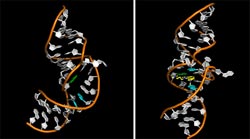Discovery Provides Blueprint for New Drugs That Can Inhibit Hepatitis C Virus

The molecule prompts the Hepatitis C’s viral RNA to open up a portion of its hinge-like structure and encapsulate the inhibitor like a perfectly fit glove.<br>
Chemists at the University of California, San Diego have produced the first high resolution structure of a molecule that when attached to the genetic material of the hepatitis C virus prevents it from reproducing.
Crystals of the molecule were produced so its structure could be determined.
Hepatitis C is a chronic infectious disease that affects some 170 million people worldwide and causes chronic liver disease and liver cancer. According to the Centers for Disease Control and Prevention, hepatitis C now kills more Americans each year than HIV.
The structure of the molecule, which was published in a paper in this week’s early online edition of the journal Proceedings of the National Academy of Sciences, provides a detailed blueprint for the design of drugs that can inhibit the replication of the hepatitis C virus, which proliferates by hijacking the cellular machinery in humans to manufacture duplicate viral particles.
Finding a way to stop that process could effectively treat viral infections of hepatitis C, for which no vaccine is currently available. But until now scientists have identified few inhibiting compounds that directly act on the virus’s ribonucleic acid (RNA) genome—the organism’s full complement of genetic material.
“This lack of detailed information on how inhibitors lock onto the viral genome target has hampered the development of better drugs,” said Thomas Hermann, an associate professor of chemistry and biochemistry at UC San Diego who headed the research team, which also included scientists from San Diego State University. The team detailed the structure of a molecule that induces the viral RNA to open up a portion of its hinge-like structure and encapsulate the inhibitor like a perfectly fit glove, blocking the ability of the hepatitis C virus to replicate.
The molecule is from a class of compounds called benzimidazoles, known to stop the production of viral proteins in infected human cells. Its three-dimensional atomic structure was determined by X-ray crystallography, a method of mapping the arrangement of atoms within a crystal, in which a beam of X-rays strikes a crystal and causes the beam of light to spread. The angles and intensities of the light beams allowed the scientists to calculate the structure of the viral RNA-inhibitor complex.
“This structure will guide approaches to rationally design better drug candidates and improve the known benzimidazole inhibitors,” said Hermann. “Also, the crystal structure demonstrates that the binding pocket for the inhibitors in the hepatitis C virus RNA resembles drug-binding pockets in proteins. This is important to help overcome the notion that RNA targets are so unlike traditional protein targets that drug discovery approaches with small molecule inhibitors are difficult to achieve for RNA.”
The study was supported by the National Institutes of Health and National Science Foundation.
Media Contact
Kim McDonald, 858-534-7572, kmcdonald@ucsd.edu
Media Contact
More Information:
http://www.ucsd.eduAll latest news from the category: Life Sciences and Chemistry
Articles and reports from the Life Sciences and chemistry area deal with applied and basic research into modern biology, chemistry and human medicine.
Valuable information can be found on a range of life sciences fields including bacteriology, biochemistry, bionics, bioinformatics, biophysics, biotechnology, genetics, geobotany, human biology, marine biology, microbiology, molecular biology, cellular biology, zoology, bioinorganic chemistry, microchemistry and environmental chemistry.
Newest articles

Zap Energy achieves 37-million-degree temperatures in a compact device
New publication reports record electron temperatures for a small-scale, sheared-flow-stabilized Z-pinch fusion device. In the nine decades since humans first produced fusion reactions, only a few fusion technologies have demonstrated…

Innovative microscopy demystifies metabolism of Alzheimer’s
Researchers at UC San Diego have deployed state-of-the art imaging techniques to discover the metabolism driving Alzheimer’s disease; results suggest new treatment strategies. Alzheimer’s disease causes significant problems with memory,…

A cause of immunodeficiency identified
After stroke and heart attack: Every year, between 250,000 and 300,000 people in Germany suffer from a stroke or heart attack. These patients suffer immune disturbances and are very frequently…





















